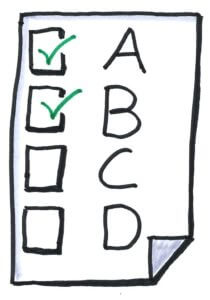Multiple Choice Test: Are They Truly Easier?
When thinking of multiple-choice tests/questions, there’s an assumption that they are easier than short answers or essay questions. However, if we don’t have strategies when approaching this style of questioning, they can become difficult and we may end up “guessing” the correct response. Multiple-choice tests/ questions are meant to test reading comprehension, so it is important to pay close attention to what the questions are asking.
The OSSLT has several sections that include multiple-choice style questions, with approximately 45 multiple choice questions in total (the number varies from year to year). Therefore, it’s important for test takers to have practical strategies when approaching these questions.

Tips for Multiple-Choice Questions
Read the question and answer options several times. This may seem like an obvious strategy but it is an important one. Reading a question more than once allows the test-taker to become more familiar with the words and the question. The more familiar the test-taker becomes with the questions and answer options, the easier it will be to identify the correct response.
Identify keywords in multiple choice questions before first reading of text. This strategy is especially helpful when the test-taker is within a time limit. Identifying keywords is helpful when reading the text, as they can pin-point the areas that are most relevant to the questions. The test-taker may choose to highlight, underline or circle key words. After identifying the key words in the multiple-choice questions, the text becomes easier to understand as the test-taker knows what areas in the text are relevant to the questions.
Make jot notes along the margins of a text. As tip 1 mentioned, it is important to read questions and answers several times. The same is true if the multiple-choice questions are based on a text. First, simply read over the text (never write, highlight, underline or circle words on a first read of a text, because it’s important as a test-taker to first become familiar with the text and the words). For the second time you read the text, it’s important to make jot-notes. This strategy is great for conserving time. As the test-taker reviews the text, they will have a summary of the reading along the margins which they can refer back to when answering the multiple choice questions.
Use a process of elimination to choose the correct answer. This strategy helps the test-taker narrow the possible correct answers. One way of knowing how to eliminate an answer option is by determining it’s relevance to the question. If the option is not related to the question or reading then it is most likely not the correct answer to the question. Scratching out the answers the test-taker knows are not related to the reading and question, will help them focus on the answer options that are most likely to be correct and make a confident choice!

Apart from the strategies listed above, Litguide provides instant feedback to its users by displaying the correct response and an explanation of why it is the best choice for the question. This is what makes Litguide the perfect tool for students who would like further explanation and tips on how to improve their multiple-choice test taking skills!